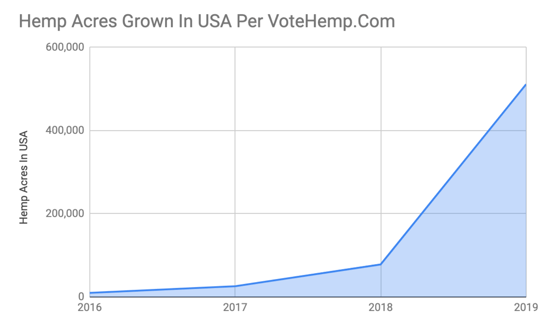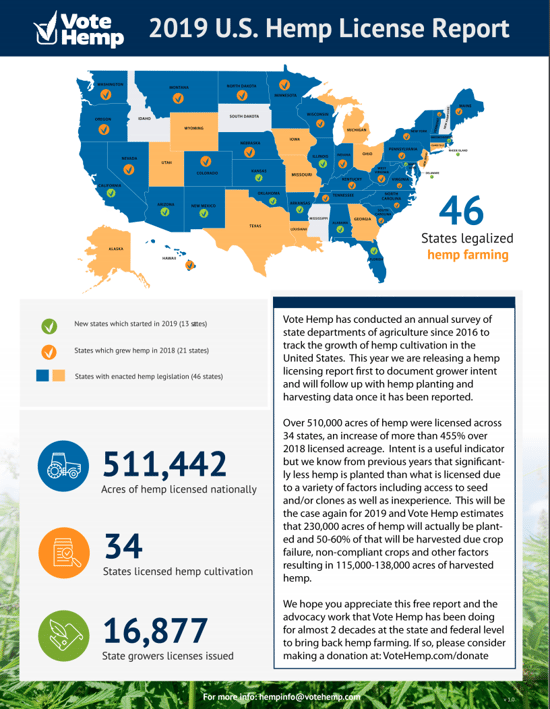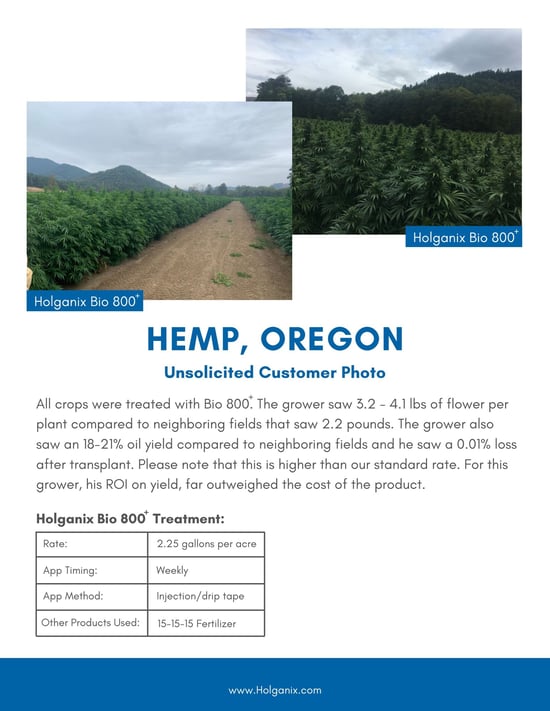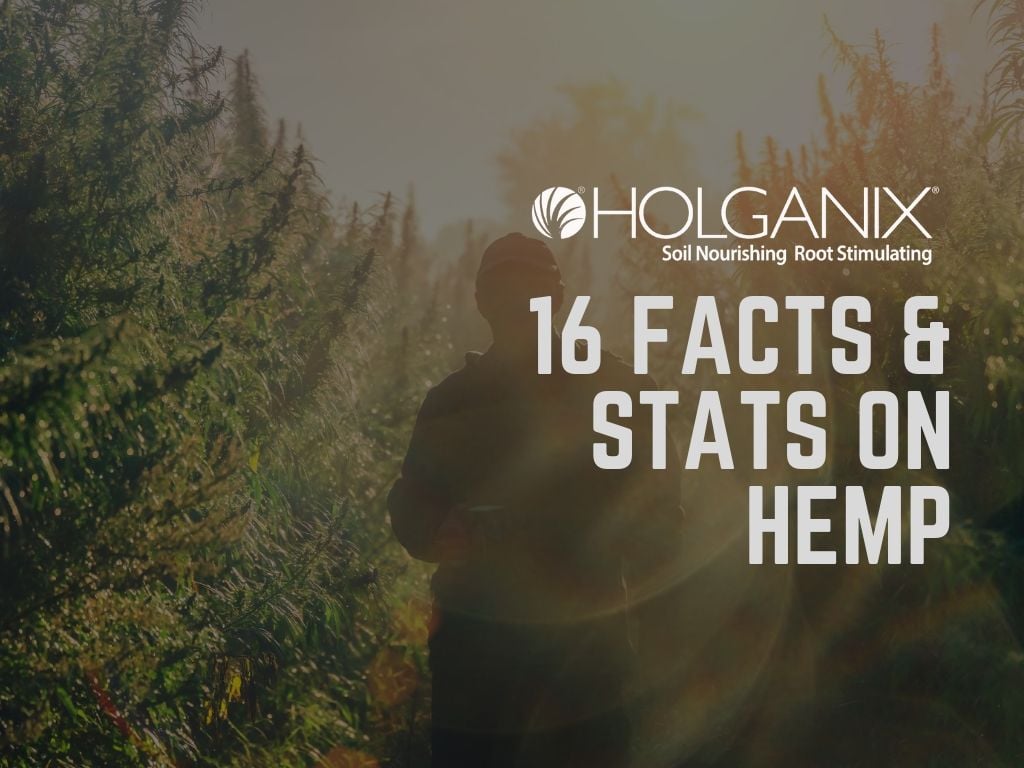.png?width=1024&name=WWW.hOLGANIX.COM%20(27).png)
“Hemp is a little like the wild west,” explains Holganix CEO and Founder, Barrett Ersek. “We are in a deregulatory environment but there is a lot of confusion around what is allowed, how it is grown, where to store it, and how to even sell it.”
Yet despite the confusion, American farmers, drawn by the profit potential, are testing and growing hemp. In fact, according to VoteHemp.com, hemp acres have been increasing in number from 9,770 acres in 2016 to 511,442 acres in 2019. And, they are expected to continue to grow annually.

Chart above created from data by VoteHemp.com
Hemp has been traditionally divided into three categories: fiber, grain, and high-cannabinoid varieties. The fiber varieties are used to produce textiles, composites, paper, fuel, and more. Grain varieties are used for food and nutritional applications. And, the cannabinoid hemp varieties are used for pharmaceutical, dietary supplements among other applications. Cannabinoid hemp has been the highest value of the three categories.
In this blog, we explore the following popular topics. Click on the link to short-cut to that particular topic.
The recommendations we are provided are based on general guidelines, check in with your local state extensions and crop consultants before opting to grow hemp.
What are the ideal growing conditions for hemp?
While hemp can thrive in most environments, the best conditions for hemp are warm-weather areas with well-drained rich soil. Consider soil testing before cultivating your hemp crop to ensure sulfur, potassium sulfate and rock phosphate levels are not too high.
A typical growing cycle for hemp is 100 to 120 days.
Plant your hemp seeds following the final frost date for your area when soil temperatures reliably reach 50 degrees Fahrenheit. For most of us in the U.S., that means planting occurs sometime between May and June.
According to Michael Bowman, Founding Chair of the National Hemp Association, “on the CBD side, you have 1,000 to 1,600 plants per acre, planted and tended to as separate plants. Traditional hemp, grown for mass-market products such as textiles and bioplastics, has a planting rate of 400,000 per acre (roughly 100 plants/square meter), and is drilled in like wheat.”
When is hemp ready to harvest?
Approximately 100 to 120 days after the seeds were planted, the crop should be ready to harvest.
Pay attention to the seed bracts. When they are fully matured they expose the seeds, allowing you to air dry them naturally.
After the flowers and/or seeds have been harvested, hemp biomass (the remaining stalks and leaves) can be harvested.
There are two methods to harvest hemp biomass, (1) for the collection of oils, leaves or fuel, and (2) for fiber, cloth or cord production. For oils, hemp biomass should be dried before processing. For fiber, the biomass should be “retted”
Check out the video below from Kush.Com on harvesting biomass. If you are reading this blog via email, click here to watch the video.
What equipment will you need to grow hemp?
Generally, there is no need to obtain special farming equipment. According to IndustrialHempFarms.com, growers should “set your combine to settings similar to those for harvesting canola or wheat. To minimize how much fiber enters the combine, cut plants immediately below the head of the grain.”
Special farming equipment may be needed if you are growing hemp for fiber as the stalks are processed differently. You can avoid the cost of purchasing new equipment by opting to use a company that will process the raw plant material.
What kind of yield should you expect with your hemp?
According to the Agriculture Marketing Resource Center, “one acre of hemp can yield an average of 700 pounds of grain, which in turn can be pressed into about 22 gallons of oil and 530 pounds of meal. The same acre will also produce an average of 5,300 pounds of straw, which can be transformed into approximately 1,300 pounds of fiber”.
What’s the difference between hemp and marijuana?
Both hemp and marijuana belong to the cannabis genus, but hemp varieties contain less than 0.3% Delta-9 THC at a flower level on a dry weight basis. Make sure you obtain the necessary permits issued by local departs of agriculture, along with state and federal agricultural laws.
Where is it legal to grow hemp?
According to Votehemp.com, 46 states have legalized hemp farming with 16,877 state growers licenses issued. Check out Votehemp.com's infographic below from their 2019 U.S. Hemp License Report.

How HGX PRO Bio 800+ Tree & Shrub can improve hemp yield and develop soil health?
HGX PRO Bio 800+ Tree & Shrub charges soils with over 800 species of soil microbes to promote soil health, improve root growth, and increase crop yield. It’s an organic solution and contains an entire microbiome or community of soil microbes that are both abundant and diverse.
Whether you are planting hemp from seed or transplanting, HGX PRO Bio 800+ Tree & Shrub will help your hemp thrive.
We’ve been working with select growers in the midwest and the northwest. Check out the report below from a grower using HGX PRO Bio 800+ Tree & Shrub on hemp in Oregon.

Want to Dig In Deeper? Check out the links below for resources on HGX PRO Bio 800+ Tree & Shrub and hemp.
>>Download our key ingredient list
>>What other crops is HGX PRO Bio 800+ products used on? Explore our research here.
 |
May 7, 2020
|
3:00 PM
|
May 7, 2020
|
3:00 PM
-2.jpg)
-1.jpg)
-1.jpg)
-1.jpg)
.jpg)

-2.jpg)
-1.jpg)
-1.jpg)
-1.jpg)
.jpg)




.png?width=1024&name=WWW.hOLGANIX.COM%20(27).png)



.webp)
-1%20(1).webp)
-831535-2.webp)



-1.png)

.jpg)